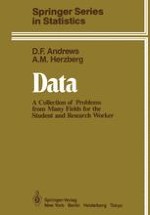1985 | OriginalPaper | Buchkapitel
Lamoka Lake Site Determinations
verfasst von : D. F. Andrews, A. M. Herzberg
Erschienen in: Data
Verlag: Springer New York
Enthalten in: Professional Book Archive
Aktivieren Sie unsere intelligente Suche, um passende Fachinhalte oder Patente zu finden.
Wählen Sie Textabschnitte aus um mit Künstlicher Intelligenz passenden Patente zu finden. powered by
Markieren Sie Textabschnitte, um KI-gestützt weitere passende Inhalte zu finden. powered by
A radiocarbon age (RC) determination is usually presented by the radiocarbon dating laboratory in the form A± E, where A is the estimate of the radiocarbon age, bp, and E is the standard deviation due to counting error. The counting error is taken to be normally distributed. If one is making inferences in real time from different samples then it is necessary to take into account the conversion of conventional radiocarbon dates (5568 half-life) denoted bp, to calendar or tree-ring dates, denoted BP. However, if one has two or more radiocarbon ages by from the same sample then to check their agreement with each other it is not necessary to consider this conversion. Such considerations are often ignored in the evaluation of a series of dates. For example, Long and Rippeteau (1974) considered the 8 dates presented in Table 19.1. This gives us seven dates, one for each of the seven different samples. Thus one can check whether these estimates may be dating the same event in real time, after taking into account the calibration error due to the need to convert from years by to BP. Ward and Wilson (1978) have re-analyzed these dates, under the assumption that the calibration error, in the years bp, is normally distributed and independent of the counting error. They found no statistical evidence to doubt the consistency of C-288 and M-26, and therefore combined these two dates. After analyzing the seven samples, and making the assumption concerning the calibration error, they found some borderline evidence that C-367 may be aberrant.
